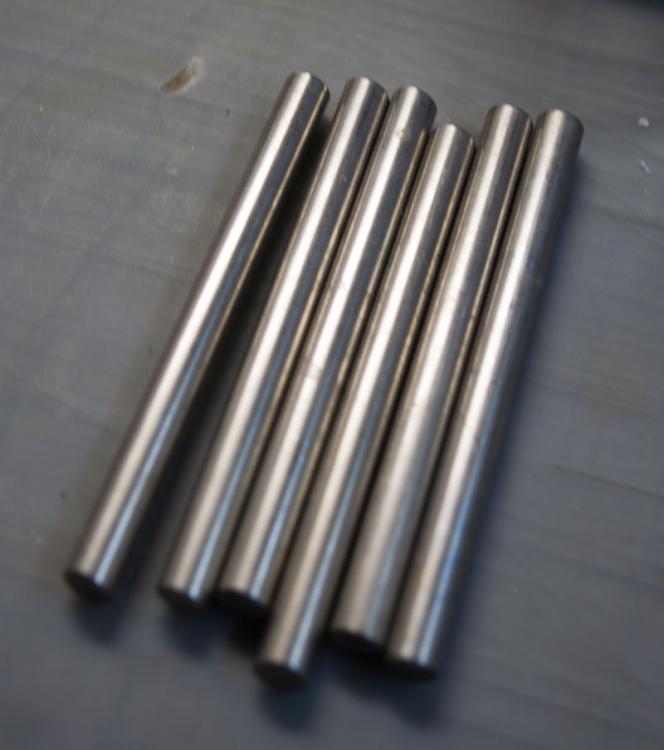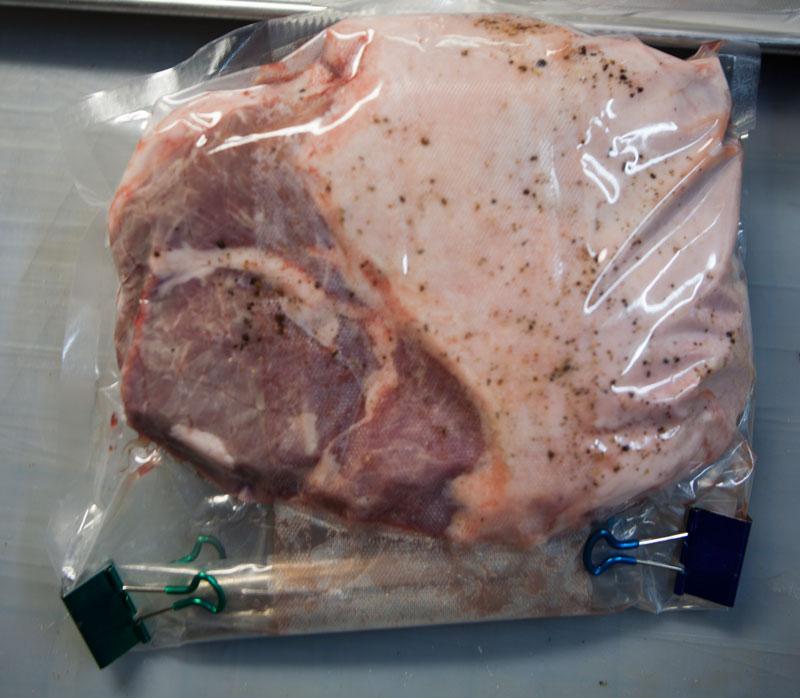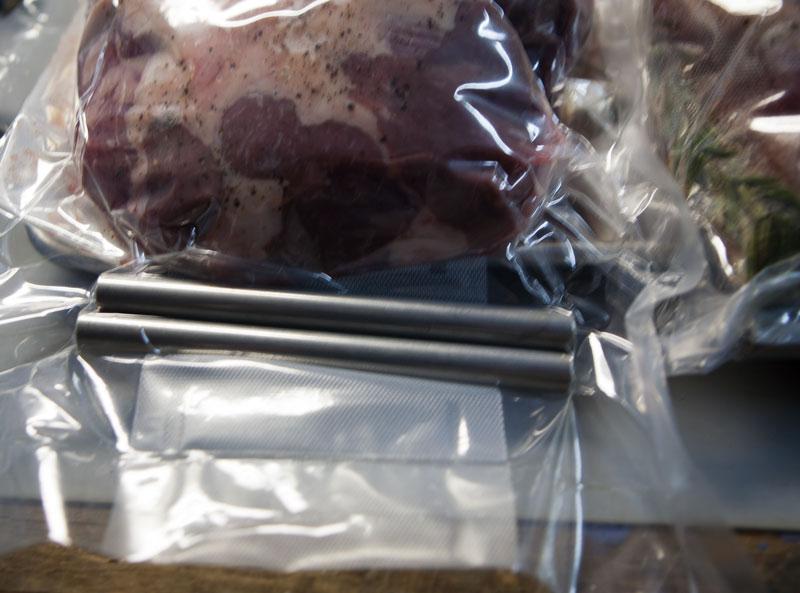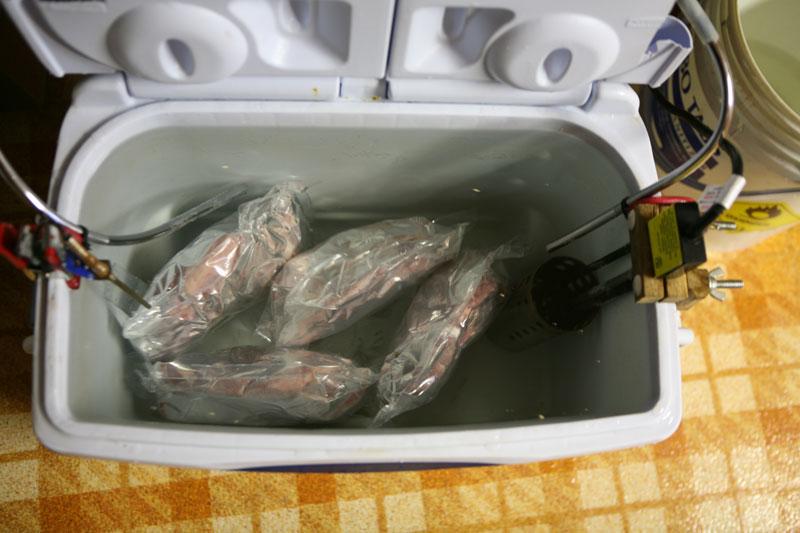
HowardLi
-
Posts
433 -
Joined
-
Last visited
Content Type
Profiles
Forums
Store
Help Articles
Posts posted by HowardLi
-
-
Make French onion soup and let us know how this technique works out?
So with a couple of little tweaks, I'd managed to whittle down a 45-minute long procedure to not much more than 15 or 20 minutes, and to be honest, the flavor developed in that short amount of time is actually deeper and more complex than the standard, slow-cooked French onion soup method (incidentally, this process is perfectly adaptable to onion soup—just add a splash of sherry and some good chicken or beef stock to the onion base and simmer it down for a few minutes. Delicious!) -
Long before Modernist and Molecular Gastronomy, as little kids, we succeeded in a high-tech sausage cooking method:
We inserted a nail at each end of a sausage, wired the nails to an electrical cord and plug the sausage into an outlet.
In no time, the sausage was done.
dcarch
Like this?
I've heard it puts a bad taste in the dog but I've never tried it myself.
-
Hate to bring this from the dead, but the thread is titled aptly enough. If doing the sausages SV, what is the best internal temp to cook to? 135F would certainly be the safe option, but is a higher temp preferred to gelatinize the tougher parts of the meat used in the sausage?
Also, re: poaching in oil, one can ziploc the sausages in oil and SV the bag. Economical, and the sausage sees nothing but oil and inert plastic.
-
Oh, by the way has anyone tried the trick where you put avocados in 100 degree water for a couple hours then refrigerate? It's supposed to change the structure of the enzymes that promote browning and they don't turn as quickly.
Jim
Is this similar to JKAL's apple texture modifying process on Serious Eats? Because that requires much higher temps.
Or perhaps lower temps work, but necessitate longer times.
-
I have seen lots of posts here about how to keep the bags from floating and thought I would share my solution. I obtained a few feet of 1/2" diameter solid stainless steel rod and cut it into 6" pieces. I filed the cut edges smooth to prevent them from cutting the bags. One or two of these are sufficient to hold down anything that might float.
If the cooking time is short I simply roll a bar or two up in the end of the bag, fold over the ends and clip them so the bars don't fall out.
For longer cooking time I double bag the meat and put a few bars in the second bag. I adjust their position as close to the seal as possible to keep the meat from sitting on the bottom of the cooker.
Here are four boneless legs of lamb in my beer cooler version that I started last night. They will cook for 24 hours at 55C and will be perfectly medium rare. I will take two out and cook the remaining two for another 6 hours at 60C for those who prefer their lamb a bit less rare. This is in preparation for our Valentine's party on Saturday. It is part of a seven course meal my men's cooking club is preparing.
Is that a toilet tank!? Ingenious!
-
Would freezing and thawing do the same thing, I wonder.
-
Try this:
http://sherylcanter.com/wordpress/2010/01/a-science-based-technique-for-seasoning-cast-iron/
Flaxseed oil seems to be highly regarded for seasoning.
-
-
Chilling scotch to drink is one thing, but putting it in the freezer? Not sure many people would recommend that.
It matters what "people recommend" because...
-
I use either a hot plate (fifth burner) with a big pot, or an immersion heater in a cooler.
-
Not a good idea for scotch, which is primarily what I've seen ice balls being used for.
Why not? You can enjoy the drink longer if you prefer it to be free of water additions.
-
Freeze the drink in the same environment as the ice.
-
At equilibrium, the ice will also be at 0 degrees (or whatever temperature the liquid is at due to alcohol depression). Because both glasses have the same amount of heat energy in the ice, whether the ice starts at -20C or -8C, the same amount of ice would melt until the ice and water were at the same temperature. Therefore, the only melting after equilibrium would be due to the heat gain from the air of the room, which, for all intents and purposes, would be the same for both glasses.
EDIT: I just realized something. If the drink is colder than 0 degrees
How do you explain crushed ice melting faster than cubed ice based on the above?
Has there been scientific testing to prove your conclusion?
-
To avoid the issue of slower rising, could you not freeze the bread after it's risen, e.g right before it's shaped for the oven?
-
Would you know how to measure the height disparity? The easiest solution is to put something in the shorter ones, or alternately put "spacers" in all of them, with differing internal heights.
The steel balls from small ball bearings might work, if you can get a few in different sizes. Barring that, you can make your own plugs out of small machine screws (I'm guessing #6-32 would be a workable size to start), and use nuts, doubled up, to set your own height.
-
So your issue is that there is no height adjustment with these plugs?
-
Could you describe in more detail these plugs?
-
Luzzo's! (east village)
-
Some sort of ceramic santoku... Kyocera?
-
The surface area of the ice is one of the factors that affect cooling rate, yes. But we are not interested in cooling rate, are we? No, only how much water gets melted for an equivalent amount of cooling.
But if you think about it, is it possible that one type of ice can be better than another? Assume all the ice is at the same temperature. You have two cups of water, one with cubed ice and one with a large ice sphere. The cubed ice glass will cool much faster. That much is obvious. Then, how do we determine how much ice melts, when the glasses are at equilibrium? Simple - the ice melts in proportion to the added heat energy from the liquid that is cooling. But, the (relative) heat energy is the same in both glasses! So what is in the cubed ice glass that allows for more ice to melted than the large sphere ice?
You'd be correct that the heat energy exchange between the liquid and ice is the same in both glasses (how much water gets melted for an equivalent amount of cooling) if the glasses were in a closed system, which they are not. You're assuming that both drinks will have the same equilibrium temperature, and thus no energy loss to the outside environment. However, the drink will not have the same equilibrium temperature. Because of the greater surface area of the cubed ice, the drink will be overall colder since it is drawing energy out of the liquid at a faster rate (faster than the rate at which the room/air can heat up the drink). It may not be much, but there will be a temperature difference in the drink with the spherical ice since the rate at which it cools the drink will be less than the rate at which the cubed ice cools its drink. Hence, if the room/air is putting heat into the system at a constant rate, the drink with the smaller cooling rate (spherical ice) has to have a greater temperature.
At equilibrium, the ice will also be at 0 degrees (or whatever temperature the liquid is at due to alcohol depression). Because both glasses have the same amount of heat energy in the ice, whether the ice starts at -20C or -8C, the same amount of ice would melt until the ice and water were at the same temperature. Therefore, the only melting after equilibrium would be due to the heat gain from the air of the room, which, for all intents and purposes, would be the same for both glasses.
EDIT: I just realized something. If the drink is colder than 0 degrees
-
The surface area of the ice is one of the factors that affect cooling rate, yes. But we are not interested in cooling rate, are we? No, only how much water gets melted for an equivalent amount of cooling.
But if you think about it, is it possible that one type of ice can be better than another? Assume all the ice is at the same temperature. You have two cups of water, one with cubed ice and one with a large ice sphere. The cubed ice glass will cool much faster. That much is obvious. Then, how do we determine how much ice melts, when the glasses are at equilibrium? Simple - the ice melts in proportion to the added heat energy from the liquid that is cooling. But, the (relative) heat energy is the same in both glasses! So what is in the cubed ice glass that allows for more ice to melted than the large sphere ice?
If you can figure that out, you may be able to win a Nobel prize...
-
It depends, I think, on whether or not the liquid is chilled prior to introduction to the ice.
If you're talking about how much ice gets melted, yes. But that doesn't depend on the shape or surface area of the ice, only the temperature differential.
By minimizing the surface area, less ice melts in a given time compared to ice with a comparatively larger surface area.
How do you figure?
-
the 1:20 at 176f was not long enough, they came out a little sloppy,
gonna try at least 2:00 next time, probably use 3 bags and pull at 2:00, 2:30, 3:00
very smooth though
I might try rebagging some of these and doing over.
I tried painting the interior of a silicone cannele mold with choc ganache but it didn't coat nicely.
The little pocket in the top is begging for something to be put in it. Something fruity, or perhaps a graham cracker streusel as a nod to the tradition.
-





The Ideal Sous Vide Controller
in Kitchen Consumer
Posted
Oh, I almost forgot. It should have a built-in temp compensator for thermocouple usage.